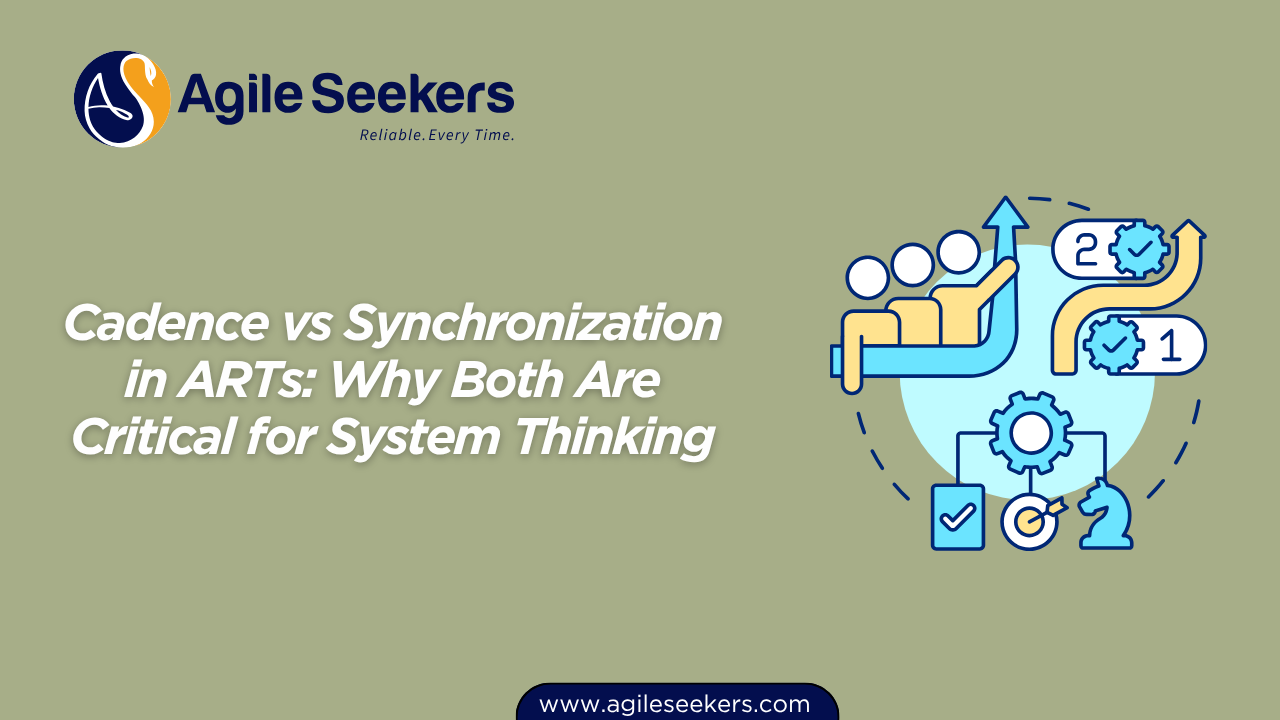Cadence vs Synchronization in ARTs: Why Both Are Critical for System Thinking

Agile Release Trains (ARTs) function as the heartbeat of the SAFe framework, enabling multiple Agile teams to collaborate, align, and deliver value continuously. Two essential principles underpin the efficiency of these ARTs: cadence and synchronization. While often used together, these are not interchangeable concepts. Each plays a distinct role, and together, they drive system thinking across teams of teams.
Understanding Cadence in ARTs
Cadence refers to a predictable rhythm or regular interval that guides the flow of work. In the context of ARTs, it defines when events happen—like Iterations, PI Planning, System Demos, and Inspect & Adapt workshops.
It brings structure to complex development efforts by helping teams:
-
Establish reliable schedules
-
Reduce decision fatigue
-
Enable flow-based planning
-
Build psychological safety through predictability
For example, when all teams on the train operate in two-week iterations, everyone knows when reviews, retrospectives, and integration efforts occur. This allows people to plan better and removes uncertainty from the system.
Teams trained under the SAFe Scrum Master Certification are equipped to use cadence to anchor key Agile ceremonies and ensure consistent delivery.
The Role of Synchronization
Synchronization focuses on alignment in time. It ensures that activities across teams—such as backlog refinement, integration, and testing—occur simultaneously, enabling effective collaboration.
This is especially critical during:
-
PI Planning, where all teams plan together
-
System Demos, where integrated work is reviewed collectively
-
ART Sync meetings, where Scrum Masters, RTEs, and Product Managers align
Without synchronization, even the best cadence won’t prevent drift. One team might be ready to demo while another is still building features, leading to misaligned priorities and blocked dependencies.
Leaders who’ve completed Leading SAFe Agilist Certification understand how synchronization fosters systems thinking across the ART, ensuring that local optimization doesn’t sabotage global outcomes.
Cadence Without Synchronization: The Illusion of Progress
A team might strictly follow a two-week cadence but operate in isolation. They complete their work, run their retrospectives, and plan the next iteration—without coordinating with other teams. The result? Misaligned dependencies, late integration, and delays.
This is where system thinking breaks down.
A SAFe Product Owner/Product Manager (POPM) trained through SAFe POPM Certification plays a crucial role in aligning priorities and features across backlogs. But even they can’t overcome poor synchronization alone.
Synchronization Without Cadence: A Coordination Nightmare
On the other hand, if teams attempt to synchronize but each follows a different cadence—Team A runs three-week sprints, Team B does two-week iterations—it becomes chaos. Coordination meetings are missed, shared deliverables are delayed, and shared services become a bottleneck.
SAFe advocates for program-level cadence precisely to avoid this complexity. The goal isn’t rigidity; it’s predictability. And predictability is essential when teams work in tightly coupled systems.
System Thinking: The Glue That Binds Cadence and Synchronization
System thinking in SAFe means viewing the ART as a whole, rather than a collection of parts. Cadence and synchronization together create the operating system that makes this possible.
-
Cadence stabilizes the environment
-
Synchronization aligns the moving parts
Release Train Engineers (RTEs) certified under SAFe RTE Certification facilitate both by enforcing timeboxes and enabling ART-level sync points. They work closely with Scrum Masters and Product Managers to ensure everyone operates in harmony.
Where Cadence and Synchronization Intersect
Let’s look at real examples where both principles intersect:
| Event | Driven by Cadence | Requires Synchronization |
|---|---|---|
| PI Planning | ✅ Yes | ✅ Yes |
| Iteration Review | ✅ Yes | ✅ Yes (System Demo) |
| ART Sync | ✅ Yes | ✅ Yes |
| Inspect & Adapt | ✅ Yes | ✅ Yes |
| Backlog Refinement | ✅ Yes | ✅ Yes (Program-level) |
In each case, cadence sets the tempo, while synchronization ensures collective participation.
Supporting Roles and Practices
To make this work at scale, SAFe encourages role-based enablement and agile leadership training:
-
SAFe Advanced Scrum Master Certification builds the capabilities of Scrum Masters to facilitate team-of-teams events and address cross-team impediments
-
Product Managers and Solution Managers contribute by ensuring shared vision and business context
-
DevOps and Release practices ensure that integration happens continuously, not just at the end of the PI
For example, external research from Scaled Agile highlights how cadence and synchronization support continuous delivery through better integration and testing cycles.
Metrics That Reflect the Power of Both
You can measure the effectiveness of cadence and synchronization through key ART metrics:
-
Predictability Measure (Program Predictability Score): Higher scores reflect well-aligned cadence and sync
-
System Demo Quality: Regular, cross-team feedback ensures higher integration quality
-
ART Flow Metrics: Balanced cadence and sync improve flow time, throughput, and load distribution
These outcomes are emphasized in many SAFe Scrum Master Training workshops, which help Scrum Masters interpret ART health using these indicators.
Final Thoughts
In Agile Release Trains, cadence and synchronization are not optional extras—they are foundational elements. Cadence brings rhythm and structure. Synchronization aligns diverse efforts into coherent delivery. And together, they enable system thinking—the very mindset that transforms Agile at scale.
Whether you're a Scrum Master, Product Owner, or Release Train Engineer, mastering both is essential. Certification programs like SAFe POPM, SAFe RTE, or Leading SAFe ensure you’re equipped not just with tools—but with the mindset needed to drive enterprise-wide agility.
Also read - How Solution Trains Align Multiple Agile Release Trains
Also see - Coordinating Releases Across ARTs




















